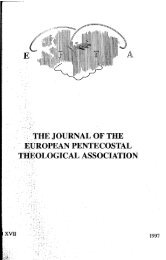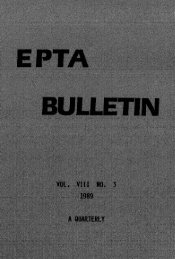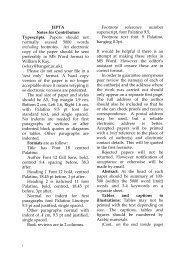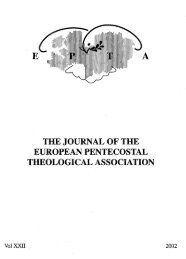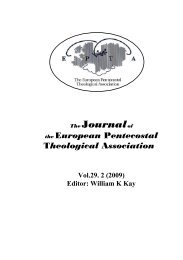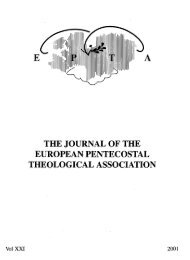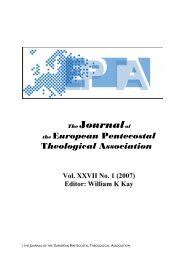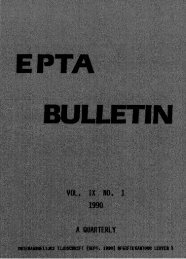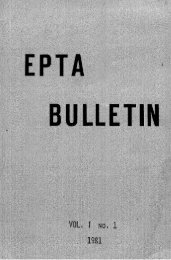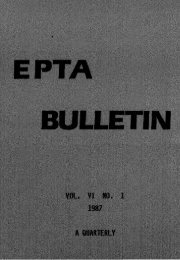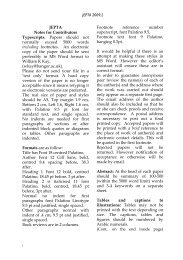jepta 1987 06-3 - European Pentecostal Theological Association
jepta 1987 06-3 - European Pentecostal Theological Association
jepta 1987 06-3 - European Pentecostal Theological Association
- No tags were found...
Create successful ePaper yourself
Turn your PDF publications into a flip-book with our unique Google optimized e-Paper software.
hinder the work of God and to respect the independence ofthe assemblies. It was decided to come together on aregular basis as leaders of the revival for a Hauptbriidertag,From then on only those with letters ofrecommendation were allowed to speak in the assembliesand centres of the revival. The responsibility to issuethese letters was entrusted to the recognized leaders,among whom Jonathan PAUL, Eugen EDEL and Emil HUMBURGwere foremost. The Hauptbrlidertag also divided the workinto areas, although some considered this a threat to thefreedom of service and had spoken against it, Under thenational Hauptbrudertag existed the BrUdertag, organizedby districts, the Provinzialbrlidertag and the evensmaller regional Bezfrksbriidertag. Soon some of theleaders were to be expelled while a few left desiringmore freedom.(31) Although the pentecostala had beenexcommunicated by the Gemeinschaftsbewegung, a number ofthe leaders and some of the centres still remained withinthe state church. Major leaders as Jonathan PAUL, whoremained Lutheran and Carl Octavius VOGET, who pastored alarge Reformed church in Bunde, tried to maintain the<strong>Pentecostal</strong> message and experience within the Lutheranand Reformed tradition.THE INTERNATIONAL PENTECOSTAL COUNCIL (1912-1914)Consultative International Penteco,stal CouncilLSunderland, May 1912At the Fifth Sunderland Convention, May 1912, itwas felt that the time was ripe to move beyond thealready existing Leaders' Meetings and to form a socalledVonsultative International <strong>Pentecostal</strong> Council.IfThe declaration of the council, published in ConfidenceJune 1912, explained, Ifin order to protect this work fromwrong teaching, or false teachers, the chief Leaders indifferent lands should meet together, once or twice ayear, to take counsel together. I' (32) Hereafter followed adoctrinal statement about the Spirit baptism startingwith:We believe that The Baptism of the Holy Spirit andFire is the coming upon and within of the HolySpirit to indwell the believer in His fulness, andis always borne witness to by the fruit of theSpirit and the outward manifestations, so that wemay receive the same gift as the disciples on theDay of Pentecost.(33)The declaration was signed by BARRATT from Norway,BODDY and POLHILL from England, POLMAN from theNetherlands, PAUL, SCHILLING and HUMBURG from Germany andJoseph Hillery KING from the U.S.A. Not all of theleaders present participated in the council. Severalspeakers at the convention, like SMITH WIGGLESWORTH, didnot take part. Apart from the declaration no furtherinformation concerning the council was given. The nextmeeting was to be held in Amsterdam.International <strong>Pentecostal</strong> Consultative Council,Amsterdam, December 1912The second session of the International Councilresulted in the most significant declaration the councilwas to make. This time BODDY added some personal observationsin Confidence, while Pfingstgrlisse also publisheda report together with a German version of the declaration,In addition to BODDY, POLNILL, BARRATT, POLMAN,PAUL and HUMBURG, who all had participated in the firstsession, C.O. VOGET from Germany and Anton B. REUSS, whorepresented Richard RUFF from Zurich (RUFF being thesuccessor of De LABILIERE) were present. Not present wereKING and SCIIILLING; the latter was about to be expelledfrom the HauptbrUdertag. (34) Because the council meetingswere not attached to a large conference like Sunderland,the leaders could devote all their attention to theissues at stake, Meetings were held on December 4 and 5,1912, at 10 a.m. and 3 p.m., each sitting lasting three
hours. While the council meetings in Sunderland wouldalways be presided over by BODDY, upon the invitation ofPOLMAN, this session was presided over by PAUL.BARRATT had again put forward the idea of a unionor alliance, but it would seem he found no support. BODDYwrote,Pastor BARRATT introduced the thought of alliance,and even of formation of Churches. Pastor PAULpreferred the thought of an 'lOrganisml' to that ofan Organization. The so-called llMovementu is reallynot a movement, but the Gift of the Holy Ghost,enabling many to be blessed in Churches or outsidethem. An 'IOrgani~rn'~ is a living thing; anorganization may be living, but we have manyorganizations which have not much life. (35)The actual declaration stated:, , , we believe that the Holy Spirit seeks tobring about true unity among all the people of God,according to the valedictory prayer of our LordJesus Christ (~ohn 18). Not a unity in which uniformityprevails as to methods of work and doctrinesthat have long divided the Church, but aunity in spirit and fraternity which recognizes thevital doctrines of Christianity. (36)In the introductory remarks of the final declaration thecouncil emphasized its position as an advisory body, notas a legislative council. As an advisory council it wasto be self-elected and not subject to the control of thevotes of assemblies. The declaration stated the convictionsof the participants concerning God's plan for thisrevival. The present outpouring of the Holy Spirit wasseen as a preparation for the "Rapture," in light ofwhich the above statement about unity in spirit andfraternity was made, added by an urgent appeal forevangelistic and missionary efforts. Next the declarationcontained some important paragraphs about the baptismwith the Holy Spirit; a call for a deepening of God'swork; and a call to follow scriptural principles in theexercise of spiritual gifts, which meant to recognize theoffices appointed in the body of Christ.The paragraphs about Spirit baptism began byrepeating part of the previous declaration and wereextended with further teaching, With PAUL as presidentand VOGET as secretary, the German tendecy to minimizethe significance of tongues prevailed. The sole directreference to tongues was in the negative: "We do notteach that all who have been baptized in the Holy Ghost,even if they should speak in tongues, have alreadyreceived the fulness of the blessing of Christ implied inthis Bapti~m.~l(37) While encouraging believers to seekthe full baptism, warnings were given against I1merelyseeking soulish experiences or fleshly demonstrations,"and against delighting Itin feelings and mystical experiences.ItEDEL, editor of Pfingstgri-isse, saw in the declarationa victory of the German position. He repeated theGerman statement of 1910, in which according to I Cor.12:13 all true children of God were consideredSpirit-baptized, and which valued the fruit of the Spiritabove the gifts of the Spirit. In his editorial EDEL waspleased to note that leaders of other countries hadagreed to these biblical principles.(38) The agreementwas not as far-reaching as EDEL had hoped. POLMAN, forexample, did not translate the declaration for the Dutchpublic and in his teaching always maintained a strongemphasis on the importance of tongues.(39) The latter canalso be said of BARRATT, who thereafter did not return tothe council meetings, During 1913 BARRATT was baptized byimmersion and left the Methodist church.(40) Influencedby the views of the former Baptist Lewi PETHRUS aboutestablishing fr~e <strong>Pentecostal</strong> assemblies, BARRATT droppedhi^ previous ideas about working along Al.liance lines. Heorganized the Work in Oslo as a free <strong>Pentecostal</strong> Churchand eventually made baptism by immersion a condition formemborship.(41)
pastoral, apologetic, doctrinal and organizationalnature, is already significant in itself. A forum of thiskind is not available today. The move from the earlierLeaders' Meetings to the International Council had thepositive result of producing four declarations, of whichthe Amsterdam declaration stands out the most; but, anegative result was its accompanying exclusion of manyother leaders. From England only BODDY and POLHILL tookpart and from Germany only those associated with theHauptbriidertag, out of which the so-called WlheimerRichtung was to grow, The Swiss participants werestrongly influenced by Germany (e.g. GEYER1s assembly inBasel was governed by Miilheim). When BARRATT no longertook part in the meetings, the already small basis waseven further limited. The council became dominated by theGerman and the two English leaders. It is this restrictedrepresentation of the wider <strong>Pentecostal</strong> movement thataccounts for its limited success. The more radicalindependent <strong>Pentecostal</strong> preachers who were establishingfree <strong>Pentecostal</strong> assemblies in England and Germany werenever involved. Often they were lay preachers coming froma lower class of society than most of the members of thecouncil. When BODDY and POLHILL in later years lost theirinfluence upon the movement, the doctrinal agreements ofthe council were soon forgotten. In Germany thesedoctrinal agreements have been preserved only in onesection of <strong>Pentecostal</strong>ism, the W'ilheimer Richtung,Cornelis VAN DER LAANMeeuwenweide 1NL - 3993 CM HoutenEndnotes(1) This paper was presented at the 4th Conference on<strong>Pentecostal</strong> and Charismatic Research in Europe, Gwatt, Switzerland:August 12-15, <strong>1987</strong>.(2) !!Words of Warningu Confidence 1,l (April 1908), p. 3.(3) IIAmerica: Important <strong>Pentecostal</strong> Manifesto,l Confidence 1,5(~ugust 1908), pp. Sf.(4) !!Beware of Unaccredited <strong>Pentecostal</strong> Workers," Ibid., p, 14,(5) "Further Warnings,!! Confidence 1,9 (~ecember 1908), p. 13.A little later BODDY once more repeated his warning -. against receivingstrangers without letters of recommendation from well-known workers.These letters had to be received separately through the post. It wasbetter to wait even for weeks for a reply than to get led intodifficulties. London and places on the continent seem to have been mostin danger. "Warning to Friends on the Continent and in Great Britain,llConfidencs 2,3 (Harch 1909) p. 65,(6) l!Declaration," Confidence 6,7 (July 1913), pp. 135f. Cf.'!The Marriage Question,fl Confidence 2,6 (June l909), p. 139.The Berlin Declaration also made reference to this kind of teaching,which was denied by the <strong>Pentecostal</strong>s in their counter-declaration.(7) IIProphetic Messages and their Trustworthiness,~ Confidence2,2 (February 1909), p. 44.(8)-Ibid., p, 42. BARRATT repeatedly warned against seekingpersonal messages in matters of ordinary life instead of using commonsense. BARRATT also spoke about a most terrific persecution in Norway,partly owing to mistakes made by some people who were being guided bytheir dreams, visions, or signs ONLY; not by the Word of God.Confidence 1,8 (Nov. 1908), pp. 21f. and 1,9 (Dec. 1908), p. 17.-,(9) IlPersonal Hessages: Their Dangers,l Confidence 5,2 (Feb.1912), p. 31, In his editorial, BODDY fully endorsed Mrs. POLMANISwarning against personal messages; - Ibid., pp. 31ff.(10) Confidence 2,2 (~eb, 1909), pp. 42ff.; 2,7 (July 1909), pp.160f.; 5,2 (Feb. 1912), pp, 30-33.(11) For a discussion see: Paul FLEISCH, Die Pfingstbewegung inPsutschland (Hannover: Heinr. Feesche Verlag, 1957), pp. 92-116; ErnstGIESE, Jonathan Paul: Ein Knecht Jesu Christi, 2nd ed. rev. (Altdorf:Missionsbuchhandlung und Verlag, 1956, 1965), pp. 150-170; Idem, 9Flicken dis Netze, 2nd. ed. rev, (Het~ingen~WUrttemberg: Ernst FranzVerlag, <strong>1987</strong>); Walter J. HOLLENWEGER, The <strong>Pentecostal</strong>s (London: SCHPress, 1972), pp. 218-230.(12) In the letter of invitation to the Berlin conference, wherethe declaration would be made,it was written:
(35) "Session of the International Council at Amsterdam,"Confidence 5,12 (~ec. 1912), p. 284.(36) Weclaration,ll - Ibid., p. 277.(37)-Ibid.(38) llNachschrift der Redaktion," PFingstgrUsse 5,15 (12. 1.1913), p. 115.(39) Cf. Cornelis VAN DER LAAN, "Gerrit Roelof Polman, SectarianAgainst His W i l l : Birth of <strong>Pentecostal</strong>ism in the Netherlands,ll Ph.0,Thesis (University of Birmingham, <strong>1987</strong>).(40) Thomas Ball BARRATT, When the Fire Fell and an Outline of-My Life (Oslo: Alfons Hansen & Sonner, 1927), pp. 178-190.(41) Cf. Nils BLOCH-HOELL, The <strong>Pentecostal</strong> Movement (0slo:Universiteitsforlaget, 1964), p. 72.(42) P. FLEISCH, Pfingstbewegung, p. 195,(43) "Declaration, Confidence 6,7 ( ~uly lgl3), pp. l35f.Cf. "The International Advisory Council (<strong>Pentecostal</strong>),l Confidence G,8(June 1913), p. 111.Confidence 5,7 (July 1912), p. 162, also contained a warningcoming from the Liverpool district against a fanatical eunuch lifeteaching. Married woman were removing their wedding rings. Certainphysical sensations were taken as indicative of the true IlBride liFe.11(44) "A Book about Demonslfl Confidence 6,1 (Jan, 1913), p, 20,When the book nas re-issued in 1917, BODDY again wrote against it: llXtis so much the best to be joyfully occupied with our beloved andVictorious Lord Jesus, rather than to be seeking to study the dark waysof demons." Confidence 10,l (March/April 1917), p. 27.(45) "Die sechste Pfingstkonferenz in Sunderland,ll PfingstgrUsse5,37 (15. 6. 1913), pp. 290-292. For a solid refutation of the diabolicargument from the <strong>Pentecostal</strong> side, see J. PAUL, Zur Dfimonenfrage(MUlhiem Ruhr: Emil Humburg, 1912).(46) Was letze Opfer der Dfimonentheorie,~~ PfingstgrUsse, 7,10(6.12,1914), p. 77.(47) "A Warning from the Advisory Couci1,l Confidence 7,6 (June1914), p. 108f.BOOK REVIEWSaonald W. DAYTON, <strong>Theological</strong> Roots of <strong>Pentecostal</strong>ism(Grand Rapids: Francis Asbury Press, <strong>1987</strong>). . on.I rr-199. Reviewed by Jean-Daniel PL~ESS , Zurich,Switzerland,As this book is written by a Methodist who teachesat a Baptist seminary, one may wonder if it had not beenmore appropriate for a <strong>Pentecostal</strong> to write about his owntheological tradition, Rut what DAYTON presents turns outto be, at least in my opinion, simply the best study onthe theological roots of twentieth centurypentecostalism. Along with Daniel BRANDT-BESSIRE's Auxsources de la spiritualit6 pentec8tiste (Geneva: ~aborxFides, 1986; reviewed in EPTA Bulletin 5,4 (198~)~ pp.137-139), which studied the same topic, DAYTONts workshould be available in every theological seminary orBible school, because it carefully relates thedevelopments of nineteenth century protestant revivalismto the theology commonly associated with the <strong>Pentecostal</strong>movement. In othar words, he does not argue that the<strong>Pentecostal</strong> movement WRR a sudden spiritual innovationfor the benefit of a church entering the age ofsecularization. Rather, he demonstrates that there is alogical. continuity from the methodist and pietistawareness of salvation, to the search for personalsanctification typical of the Holiness movement, to theplea for spiritual. power from above. In this way, heimplicitly shows that the <strong>Pentecostal</strong> movement haspotential to overcome problems of identity in the lightof growing in~titutionalizatian, precisely because it isa historical movement in the first place.That much praise for a book with less than 200pages must, of course, be substantiated. First, it shouldbe noted that DAYTON begins his study by arguing that theissue of Itspenking in tongues" is not the most profitablestarting point for a theological analysis of
<strong>Pentecostal</strong>ism because it is neither a unique nor atheologically relevant phenomenon. Instead DAYTQNproposes to study the movementts theology in the light ofthe ''Four Square Gospel.ft A concept first expounded asthe "four-fold gospel" (Jesus saves, sanctifies, heals,and comes again) by A.B. SIMPSON the founder of the'ItChristian and Missionary Alliance, and thenconceptualized by Aimee Semple McPHERSON, founder of theI1International Church of the Foursquare Gospel," intothe four kerygmatic slogans : ItJesus saves, " ItJesussanctifiesltl "Jesus baptizes with the Holy Spirit," and"Jesus is coming again." This change, DAYTON argues, canbe traced as a development in historical theology. Andthe' subsequent chapters in his book are basically anillustration of this assumption. The obvious advantagesare twofold: On the one hand, <strong>Pentecostal</strong>ism can be shownto be a development within Christianity, rather than as a' new sectarian movement arising at a time of.socio-economic change, On the other hand, the historicaLnexus, further underlined in the "latter rain" argument,explains the "signs and wonders following" apologeticallyas a logical consequence of God's plan of salvation.Second, the ambivalence between christolopy andpneumatology characteristic of pentecostal spiritualityis traced back to the spiritual convictions of JohnWESLEY and the diverging pneumatological emphases of hiesuccessor-to-be John FLETCHER. WESLEY took the "witnessof the Spirit" in the heart of the believer so seriouslythat he admited the possibility of a crisis or processexperience working the "fruit of the Spirit" following aconversion to Christ and aiming at spiritual perfection.DAYTON explains how FLETCHER pursued this road, byarguing that the Church had at Pentecost entered .thedispensation of the Holy Spirit. h he others being thedispensation of the Father in the Old Testament and thatof the Son during the life, death and resurrection of~esus.) This new formulation of salvation historyinitiated a hermeneutical. shift from a preoccupation withthe Pauline writing8 to a christian Weltanschaung akin tothe Book of Acts-Chapters three to six trace the historicaldevelopment of the three other corners of the Foursquare.They are entitled "The American Revival of ChristianperfectionM (pp. 63-84), "The Triumph of the Doctrine of<strong>Pentecostal</strong> Spirit B~ptixm" (pp, 87-113), "The Rise ofthe Divine Henl.ing Movement" (pp. 115-141), and "The Riseof Premillenidism" ( pp. 143-171 ). DAYTON concludes :Itwith this development the stage has been set for theemergence of <strong>Pentecostal</strong>ism. Nearly every wing of thelate nineteenth-century revivalism was teaching in oneform or another all. the basic themes of <strong>Pentecostal</strong>ismexcept for the experience of glossolaia, or 'speaking intongues."' (P. 167) In the light of DAYTONts expos8, oneeasily recognizes why the pentecostal revival spread sorapidly over the west;ern world. In his work, though, theauthor remains reapcctful of the spiritual gift whichconstitutes the birth of the <strong>Pentecostal</strong> movement,AB this review cannot point; to all aspects ofDAYTON's work; it might suffice to point to some of thestimulating topics under discussion: cultural optimismand the Oberlin teaching of entire sanctification, thephenomenal influence or Phoebe PALMER, the emerging useof the phrase "baptism of the Holy Spirit,It FLETCHER'Slink between pneumatology and eschatology, the role ofthe American Civil War as a turning point in Holinesstheology and It evangelical consensus, I' etc, However,DAYTON does not dwell on the black influence on the oralliturgical practices of <strong>Pentecostal</strong>ism. Neither does heunearth the roots of the typically inter-racial andheterogeneous charnter of early pentecostal spirituality.Nevertheless, what Donald DAYTON has tackled he has donewell, The 10 page bibliographic essay, the three indexes,and the various h,ymns (printed with their scores)exemplifying holiness and pentecostal theology completethis valuable book.
Xavier DURRWELL, De Heilige Geest van God. Woord enBeleving (Tielt , Belgium: Lannoo, 1986) , pp. 236.Translated by the Benedictines of Oosterhout,Netherlands (Original title llLIPsprit Saint deDieu. Paris: Edition du Cerf). Reviewed by John I.KARSTEN, Zeist, The Netherlands.DURRWELL is a Roman Catholic priest who it3currently a professor at the University of Metz. In hisstudy of the Holy Spirit, he attempts to be guided byScripture rather than by theological systems although heremains loyal to the faith of the Roman Catholic Church.Scripture is considered to be best read from a personalperspective so that the death and resurrection of Christis the focal point of the revelation of the Spirit.The Spirit is a mystery and, thus, ineffable. Me istlexperienceable" and can therefore be the subject ofspeech. DURRWELL discusses, *in order: "The Spirit ofGod," "The Spirit of Christ," !!The Spirit of Christ inthe Church,I1 and "The Spirit of the Father and the Son,t'As the Spirit of God is spirit and personal, he iatherefore God in action. His power, glory, holiness, loveand life are extensively examined through scripture, TheSpirit is seen as the maker of history and as present atboth creation and consumation. In "The Spirit of Christl1the important role of the Spirit in the life, death andresurrection of Christ is carefully developed. His deathand resurrection are underlined as the major entrance ofthe Spirit into human history. A major part of the booka (pp. 93-194) considers under six headings the Spirit ofChrist in the Church. Much of the doctrine is recognizableand acceptable. Some catholic points are to be found(e.g., the spirit is given through baptism, confirmationis just that), while other dogmas are lacking. The popeis no where mentioned. Also absent is any flcharismaticllconnection. No charismatic or pentecostal literature isused, nor are these movements mentioned, The giftsthemselves are not discussed. A careful reader willdiscern some "higher critical" assumptions. DURRWELL1sof different levels of inspiration (see p.132and note 67) and possibly universal redemption must alsobe mentioned. In the main though, the book is well worthstudying au R major contribution to the subject.David F. HARTZFELD and Charles NIENKIRCHEN with a forwordby Denis P. KINLAW, The Birth of a Vision: Essayson the Ministry and Thought of Albert B. Simpson,Founder of the Christian and Missionary Alliance(Ilia Dominion Supplement, 1; Reaina: Canadian Theo-..logical Seminary, l986), xvi +-305 pp. Reviewed byDavid BUNDY, Lexington, KY, USA,Albert Benjamin SIMPSQN (1843-1919) is a figure ofmajor importance for <strong>European</strong> <strong>Pentecostal</strong>ism. It was, forexample, he who first articulated and codified theflFourfold Gospeltt (Christ as Saviour, Healer, Sanctifierand Coming King) which was adopted by <strong>European</strong>pentecostal. theologians and church leaders such as T.B.BARRATT, Loui~ DALLIRRE, 'Lewi PETHRUS, Anna LARSSEN-BJORNER, Donald GEE and a host of others, As well, it hasbeen known for Rome 'time that T.B. BARRATT experiencedhealing and glossolalia in the context of a visit to the"Alliance Housett and participation in Gospel Tabernaclemeetings in New York between October 7 and November 15,1907. What has only recently become known is that SIMPSONpublished BARRATT1s testimony, "The Seal of my Pentecost,"in his anonymously published periodical, Livin~Truth 6,12 (Dec. 19<strong>06</strong>), pp. 735-738 (With thanks to Prof.Cecil M. ROBECK, jr., Fuller <strong>Theological</strong> Seminary,Pasadena, for a copy of this article). As well, SIMPSONtsrecently rediscovered diary indicates his own quest forthe ItBaptism of the Holy Sprittt and his profound sympathyfor the goals of the early Pantecostal movement.
Despite his importance for North American and<strong>European</strong> spirituality, SIMPSON has been little studied*This volume of "Essays by the faculty of Canadian BibleCollege and Canadian <strong>Theological</strong> Seminary, Regina,Saskatachewan... on the occasion of the centennial of theChristian and Missionary Alliance 1887-<strong>1987</strong>tt is a mostwelcome contribution to the discussion. The twelve essaysinclude those of: John SWAIN, "The Fourfold ~ospeX, 't (pp*1-28); John V. DAHMS, "The Social Interest and Concern ofA.B. Simpsonltt (pp. 29-74); Eugene RIVARD, ItRediscoveringthe Music of A.B. Simp~on,~~ (pp. 75-1<strong>06</strong>); SIJ. STOESZ,"The Doctrine of Sanctification in the Thought of A.B.Simpson (pp. 107-124); Charles NIENKIRCHEN, "A.B. Simpson:Forerunner and Critic of the <strong>Pentecostal</strong> Movementltt(pp. 125-164); D. RATZLAFF, "An Old Mediaeval Message: ATurning Point in the Life of A.B. Simpson," (pp.165-194); T.V. THOMAS and K. DRAPER, "A.B. Simpson andWorld Evangelism, ( pp. 195-218) ; L. ANDREWS , ItRestrictedFreedom: A.B. Simpsonts View of Women in the Mini~try,'~(pp, 219-240); J.P. KLASSEN, ItA.B. Simpson and theTensions in the Preparation of Missionariesltl (pp.241-260); P.L. KING, !!Early Alliance Missions in China,"(pp. 261-278) ; and, John SWAIN, 'IPublications of A.B.Simpson, It (pp. 279-305).The essays vary greatly in quality and in theirsignificance for pentecostal history and theology. A l lcannot be discussed here and so the focus will be on thework of SWAIN and NIENKIRCHEN. SWAINts exposition of theVourfold Gospel" provides a basis for initial comparisonswith parallel pentecostal constructions. Thebibliography established for A.B. SIMPSON provides thebasis for future research. Especially helpful are hisidentification of anonymous publications and thesuggestions of order of publication for undated works.One does regret that incomplete bibliographic data isoften given. The format of an annotated bibliographywould have provided a much more useful result. For ananalysis of the material most immediately useful forunderstanding early relations between the Christian and~~lifornia, Article Nr. 15, 72 pp.)NIENKIRCMEN draws from a wide variety of sources ashe notes early pentecostal indebtedness to the CMA and to.SIMPSON, Many early penteco~tal leaders were part of theCMA, including Alice Belle GARRIGUS, D. Wesley MYLAND,John W. WELSH, Will.iam 1. EVANS, and Frank M. BOYD. Fromthe biographical, the essay proceeds to the theologicaland ecclesiological ~ Q O ~ E of ! <strong>Pentecostal</strong>ism as found inthe CMA. Finnll.~, aspects of SIMPSON Is discomfort withthe developing movement; are noted. These were primarily:(1) concern over early expectations that actual foreignlanguages were received through the experience of glossolalia;(2) the Itevidence doctrine" and the consequentexclusivist and elitist attitudes ; (3) the unwillingnessof pentecostal Christians to cooperate with those whoseexperience of the Spirit was different; and, (4) thedeleterious effect of what- became ideological struggleson spiritual renewal within the churches and the largercultural context,The volume contains much other information relevantto pentcostal history and traditions, Unfortunately,there is no index to facilitate access, There are alsonumerous errors of detail which missed the eyes ofproof-readers and editors, such as the statement, p.110,that MOODY became one of the main speakers at the firstKeswick Convention1 It w i l l be interesting to see how' often that assertion is repeated1 Such concerns aside,the volume is exemplary for a movement/church attemptingto rediscover its heritage and to draw strength from thatfor future ventures. Triumphalism is rarely a problem andthe contributors are to be congratulated for theirefforts to look objectively at their tradition and the
founder of their church. As well, through their efforts,they have made a contribution to the study of Americanrevivalism and its spiritual descendents,Randle MANWARING, From Controversy to Co-existence:Evangelicals in the Church of England, 1914 -1980(Cambridge: Cambridge University Press, 1985), xi +, - -227 pp. Reviewed by George GARIN, Kinshasa, Zaire.MANWARING chronicles the development of theevangelical wing within the Church of England from theisolationist and anti-intellectual stance of thebeginning of itsperiod (Itsiege mentalityltt "last ditchstand for Protestant integrityft) to what he feels is thecurrent and positive attitude, one characterized by "atruly Bible-inspired redemptioAist theology, embracingboth church and society, with responsibility fully feltin both spheres (p. x). Those interested in eitherEvangelicalism or the history of the Church of England inthis period will find much to appreciate here. I4e is ableto bring the period under study to life again. Forexample, his treatment of the controversy surrounding thepublication of Honest to God by the then Bishop ofWoolwich, John A.T. ROBINSON in 1963 (whose relativelyearly death three years ago saddened many), recallsvividly the shock such a work created in general churchcircles in England, and not just among Evangelicals.Today, what with the dissemination of proposals such asthose of John HICK on the convergence of religions andDon CUPITT, ROBINSONts book seems rather tame and dated,as indeed it was at the time (for it did nothing butpopularize notions of German theologians developed overthe previous twenty or so years). But many Christians(and a number of theologians) were not quite ready forwhat was regarded by many as an attack upon the basis ofthe christian faith, Another instructive section isMANWARING'S acc~unt of the effect of the Billy GRAHAMcrusades of 1954-1955 (PP. 87-95).MANWARING attempts throughout to present adifferentiated view of the various strands within~vangelicalism. There are the Fundamentalists (chapter 9)and the Charismatics (chapter 13); the hard-line~~lvinista behind the "Banner of Truth Trust1' (p, 172)and the more pit?tist;ically oriented Keswick Convention.Further are mentioned the division by Gavin REID betweenthe protestant, Keswick, eclectic, and charismaticstrands (p. 208), or MANWARINGts own "three main, inter- .related forms, right wing, central and left wing or.. .the hard-liner,'the conservative and the more liberal, allgladly owning up to 'the title 'Evange1icalWt(PP. 210f.).While helpful, these distinctions are bound to besomewhat confusing to those without extensive knowledgeof Evangelicalism.What exactly is an Evangelical? And more precisely,what is an anglican Evangelical? To the former, MANWARINGsuggasts (in what many Evangelicals would doubtlessregard as a minimalist definition) that "to be anEvangelical is and always has been to submit to the soleand absolute certainty of Scripture, 'God-breathedt but,like tho Lord Christ FIlmself, containing both the humanand the divinefv (pp, 192f. , see also J. I. PACKERt s defi- 'nition cited on p. 205). Evangelicals regard themselvesas the true succemors and guardians of Reformationdoctrine, tradi4Aonally emphasizing such doctrines asjustification by faith through Chrl~t~substitutionary 'atonement, *the authority of Scripture, the fall, andChrist's physical rosursection (see pp, 141, 192f., 205,210). To this the "anglican" Evangelical would addhis/her loyalty to the Thirty-nine Articles of the Churchof England aa encapsulating the reformed catholic faith(pp. 140f.). The anglican Evangelical tends to regardhim/herself as 'Ithe equivalent of historic Anglicani~m,~~and is especially sceptical of innovations wrought by theanglo-catholic wing (p, 191). Generally, according to
MANWARING, the englican Evangelical w i l l feel himselfmuch closer to the free churches than to Anglo-cathdicseyet, anglican ~vangelicals and Anglo-catholic8 Can makestrange bedfellows in their resistance to the Revisedprayer Book of 1927/28 or the unification scheme with theMethodists (see pp. 36f., 124-1291.MANWARINGfs own sympathies for Evangelicalism areevident, but he does attempt to treat opponen.ts fairly.John STOTT, the "acknowledged leader of EvangelicalAnglicans" (p. 98) and J.I. PACKER are two of the centralfigures on MANWARING' s book, both evidencing a modernevangelical outlook open to intellectual treatments ofEvangelicalism, at least some biblical criticism, and arefusal to withdraw into an other-worldly piety. Still,MANWARING would have been well-advised to tone down hisuse of effusive adjectives in describing the ltheroestl ofEvangelicalism. Thus, Evangelicals are (take your pick)ltsplendidtl or "magnif icent" in missionary endeavour (pp.ix, 2), engaged in "heroic" efforts (p. 37). BishopHandley MOULE is "saintly and erudite,I1 and lest weforget, ltsaintlyll again (pp. 4, 13). Bishop John TaylorSMITH possessed, MANWARING informs us, a ~~mellifluousuvoice, to which a page later is added "deep and sonorous1t(pp. 4f.) Basil GOUGH is "the gentliest of men" and AlanSTIBBS is "that most perceptive and delightful Biblicalscholart1 (p. 163). Evangelicalismls antagonists do notfare quite as well adjectivally: a book of Bishop BARNESis characterized by Itits unscholarly procedures andunscientific assumptionsf1 (p. 41) , a perhaps defendableaccusation if only MANWARING would substantiate it, buthe does not, leaving only a blanket rejection (so typicalof much of Evangelicalism's method in dealing wi-thuncongenial works). MANWARING tries hard to enlist suchmen as Karl BARTN, C.S. LEWIS and C.E.M. JOAD for theevangelical cause, though he is forced to admit that KarlBARTH is no "exact" Evangelical, nor JOAD a "preciseu one(whatever those terms mean, pp. 75, 83). Many accoladesare heaped upon LEWIS, admittedly the most effectiveapologist in the English language this century, thoughLEWIS would never have appreciated a label other than~Christian, The highest praise for the writing ofanwriter Beems to be that it resemblesLEWIS'. Thus John STOTT is at times "like C.S. Lewis inand J. I. PACKER ' 8 ttscintillating illustrations of~hristi~n truth are reminiscent of C.S. Lewisll (pp, 119,199). Having read much of LEWIS and little of the othertwo, I can only remark 'that I would never have thought of~such a comparison. Still, MANWARING can be wondeFfullyironic about some of the provincial tendencies in~vangelicalism. Thus, when Ruth GRAHAM (wife of Billy)~accompanied her evangelist-husband to England wearingmake-up, the uae of make-up "became an immediatelv-"acceptble practice with Evangelicalsf1 (p. 84).As an anglican priest and theologian, and one whoonce (it seems so long ago now, existentially if notchrono1ogicfid.I.y) called himself an "evangelical ,I1 I:appreciated MANWAR'SNOts study. It is the best treatment Iknow of the area circumscribed by the title.JiJrgen MOLTMANN, God in Creation: A New Theology ofCreation and the Spirit of God an Francisco, CA:IHarper & Row, 19861, pp. 365. Reviewed by William 1K. KAY, Mattersy Hal1 England.MOLTMANNts new book is interesting, stimulating,often edifying and both philosophical and biblical, Itforms part of a larger series, the first section ofwhich, The Trinity and the Kingdom of God, was publishedin 1980, This book is the second part and future booksare intended to deal with christology, eschatology andthe foundations of thaalogy,MOLTMANN discusses the act of creation and thecreation itself by reference to God's own essence and hiseventual intention for the cosmos, It is hard tosummarize all the comments and arguments which areII
deployed and, in any event, the breadth of theseconsiderations and the speed at which they Pass beforethe reader is exhilarating and would be misrepresented byfurther abbreviation. The author, however, considers thecreation as a whole as the place for God's dwelling, muchas the temple in the Old Testament was the speciallocation for the Shekinah - a doctrine MOLTMANN knowinglytakes over from Jewish Kabbalistic theology. Havingargued this, though, he must discuss the nature of time,its beginning and possible end. Did time begin ineternity and what is the relation of eternity to time? 1stime only conceivable where there is space, and if so,what is the relation of these two entities? Is heaven tobe understood as different from eternity,and whatdifference would be made to the Bible if it had begunwith the words, "In the beginning God made the earthurather than Itthe heavens and the earthtt? In effectMOLTMANN argues that history is not a closed system andthat the universe can not be. closed either, This isbecause he wishes to leave the future open to God, but itis clear from the range of factors he draws into hisdiscourse that he must interact with modern science andwith western philosophy since the Enlightenment. Given,however, his focus on the Trinity in the process ofcreation and his understanding of the role of thedifferent Persons of the Trinity when creation hasfinally been redeemed - and here he has in mind the,exaltation of Christ in Ephesians and Colossians and theshining glory of God in the penultimate chapter of thebook of Revelation - we have an expository thrust whichavoids dry formalism and unhelpful hair-splitting. On theother hand, we do not have a glorified panentheism eitheror a kind of mystical philosophising. It seems to thisreviewer that MOLTMANNts grasp of Scripture is aufficientlystrong to satisfy Spirit-filled Christians and tomake a genuine contribution to our understanding of the!'power of the world to come.t1There are, of course, matters in the book one would .like to question. The subtitle emphasises the work of theHO~Y spirit, but this emphasis is not really borne out inthe body of the book* Nor did I find a connection, as I .have liked, between the Spirit in creation and theSpirit in the church, The final chapter on The Sabbath asthe beginning of the Kinadom of Glory is aestheticallysatisfying, but I am not SUP@ how it is linked withMOLTMANNIB earlier Trinitarian concerns or hisexploration of heaven, earth and time,~evertheles~, this book was a pleasure to read.arb&111, NOTES1986 : Pinaebevegelsen i Norge (Oslo: Filadelfiaforlaget)This yearbook is a fine review and presentation ofthe Norwegian <strong>Pentecostal</strong> mavement and its ministries in1986. Reports on national conferences, evangelistic andmissionary activities are featured. Included are usefullydetailed statistics as well as address lists of allchurches in the movement, their leading elders andpreachers, Of special interest is a 30-year (1955-1985)growth analysis of the congregations in the variousregions of Norway, These and more make this little volumea storehouse of information on one of the important andoldest national Penteco~tal movements in Europe.H.C.S.
Olof DJURFELDT, "Gemeindewachstum durch Power Evangelism?Itin Wort und Geist 9 (l987), SL 74-13),Im Hinblick auf den Deutschland-Besuch John WXMBERShat Olof DJURFELDT einige ntichterne Akzente gesetzt, Wennes diesem t~Heilungsevangelisten" um den Willen Gottesgeht, so wie Jesus sich i m Johannes-Evangelium von ~leinernVater abhangig wusste, dam wird er in Demut Heilung imZusammenhang m i t der VersBhnung In Christus predigenmeint DJURFELDT, Chef-Redaktor der schwedischen pfingstlichenTageszeitung DAGEN, Fur WIMBER spricht die Tatsache,dass er m i t einem grossen Team von Mitarbeiternwirkt; er will offenbar nicht ein apek'takuliiirarEinzelganger sein. Trotzdem ruft DJURFELDT zur Wachsamkeitauf, alles, ob neu oder traditionell vor der Bibs1zu priifen.John LANCASTER, The Spirit-filled Church: A CompleteHandbook for the charismatic Church. With aforeword bv Michael GREEN and an introduction byDavid PAWSON (Chichester, Sovereign Word Ltd, ,<strong>1987</strong>, First ed. 1973), pp, xiii t 147.John LANCASTER has forty years of experience inpastoral ministry. He served as editor of the ErimEvangel (two years) and as a lecturer in systematictheology at Elim Bible College, In eleven chapters hediscusses the Spirit-filledchurch under the headings:"Doctrine - Bible Based and Christ Centered," "LastThings First, It I1Full Salvation, and "Divine Dynamic. " Hefollows the discussion of doctrine with a treatise of thechurch's membership, fellowship, ministry, gifts,worship, outreach, and continuance. Notable ommissionsare the sacraments and discipline. The teaching appearsto be acceptable to Evangelicals (both American andCONTRIBUTORS: J.L.K. = John L. KARSTEN; J.D.P. aJean-Daniel PLUESS ; I-I. C, S. = Heinrich C. SCHERZ,IV, RECENT PUBLICATIONSUwe BTRNSTEIN, Neuor Geiat in alter Kirche? Diechariematische,, ,Bewe&ung in der Offensive (stusgart, Kreuz Verlag, <strong>1987</strong>), pp, 219.Danie '1 BRANDT-RESSIRE , Considerations , historiques,th6ologjlques et biblio~raphique~l concernant directernentou indirectemsnt le mouvement de pentecdtefrancophone belge (1928-1982) (privately published:Rudy BEKKESS, 26 Cloe Sinius, 1200 Bruxelles.W87), pp. 119,Gary M. BURGE, The Anointed Community: The Holy Spirit inthe Johannine Tradition (Grand Rapids, MI: Eerdmans,<strong>1987</strong>), 269 pp.EarleE. CAIRNS, An Endless Line of Splendor: Revivalsand their Leaders from the Great Awakening to thePresent (Wheaton, IL: Tyndale House Publishers,
The Greek Orthodox <strong>Theological</strong> Review Theme: llEcurnenlcalPers~ectives on the Holy Sprit,I1 31,3+4 (Fall,H. Leon McBETH, The Baptist Heritage: Four Centuries ofBaptist Witness (Nashville, TN: Broadman, <strong>1987</strong>) ,850 pp.Charles Edward WHITE, The Beauty of Holinem: PhoebePalmer as Theologian, Revivalist, Fernini~lt andHumanitarian . . . -.- - (Grand Rapids, MI: Francis AsburyPress, 1986), pp. 330.V, CHRONICLEGREAT BRITAIN. The University of Birmingham accepted in June <strong>1987</strong> twopH.D. DISSERTATIONS written on pentecostal topics. One is the work ofCornelis VAN DER LAAN (interim secretary of the Executive Council ofthe Broederschap van Pinkstergemeenten, the Netherlands) and isentitled, "Gerrit Roelof Polman, Sectarian Against his W i l l : Birth of<strong>Pentecostal</strong>ism in the Netherlands.!! This interesting study on the firstleader of the Dutch <strong>Pentecostal</strong> movement w i l l be translated into Dutchand published by J.H. Kok, Kampen, in 1988. Plans are also made to makethe work available in English. The other dissertation is written byMartin ROBINSON, general secretary of the Church of Christ in England,' and is entitled IITo the Ends of the Earth - The Pilgrimage of anEcumenical <strong>Pentecostal</strong>, David du Plessis 1905-<strong>1987</strong>.11 (Correspondent:J.0. PLUESS)ITALY. The third meeting of the PENTECOSTAL / ROMAN CATHOLIC DIALOGUEwas held in Venice, at the Casa Cardinal Piazza from August 1-8, <strong>1987</strong>.This is the third phase of the dialogue sponsored by the VaticanSecretariat for the Promotion of Christian Unity and certainindividuals from the classic pentecostal churches. Co-chairman of thisphase, which is scheduled to last five years, are Justus DU PLESSIS( ~ ~ ~ s t oFaith l i c Mission of South Africa) for the <strong>Pentecostal</strong>s andKilian McDONNELLt OSB, of St. John's University, Collegeville,Minnesota (USA)The topic of this latest meeting followed the pattern set inyears. The <strong>1987</strong> theme was I1Koinonia, Church and Sacraments!!and the major papers were presented by Howard ERVIN (Oral Roberts. university, Tulsa, OK, LISA) for the p0ntecostal view and Hervh LEGRAND,op, (Institut Catholiquo, Paris, France) for the Catholic position.These papers formed the basis for the dialogue which took place during, the week in context of prayer and an atmosphere of friendship. Thediscussion raised critical questions which each group addressed to theother. Areas of common ground were also expressed,The next session w i l l be held in August 1988 on the theme ofKoinonia and baptism, (Correspondent Jerry SANDIDGE)SWITZERLAND, Forty scholars and pastors met at; the Reformed RetreatCenter of Gwatt (12-15 ~ugust) for the FOURTH CONFERENCE ON PENTECOSTALAND CHARISMATIC RESEARCH IN EUROPE, The participants came from tencountries representing fifteen universities and Bible schools. Inaddition to the pentecostwl theologians and historians there werelutheran, mothodist, roman catholi~ and reformed scholars present.The lectures doalt uith a variety of historical and theologicalissues. There were presentations discussing the function of eschatologyin pentecostal theology, biblical hermeneutics and theories of biblicalinspiration, mysticism, and the pentscostal under8tanding of corporality.Another lecture explored the theological roots of <strong>Pentecostal</strong>ismand offered a model for interpreting the variou~ theological develop-ments and formulations OF the tradition,Historical lectures included analyses of an early Englishpentecostal philanthropist-layman (c. ~0Ltl1l.L) and French philosopher- 'theologian (Louis DALLIERE) as well as a study of the pre- World War I .international and ecumenical conferences organized in England, theNetherlands and Germanyr There was a presentation on the charismaticrenewal in Finland by or. Harri HEINO, director of the ResearchInstitut of the Lutheran Church in Finland, A highlight of the'
.conference was an address by Prof. Or, Walter HOLLENMEGER on healing,in which he discussed historical, theological and pastoral issues.(Correspondent: David BUNDY)




